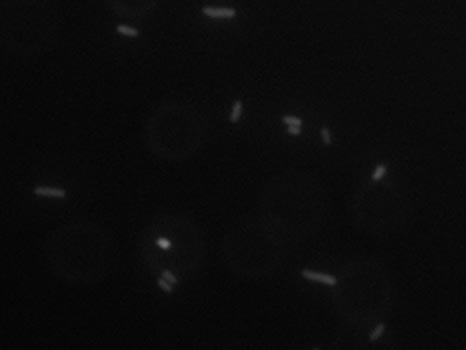Edinburgh/DivisionPopper/Status
From 2007.igem.org
| Line 20: | Line 20: | ||
* Purify the reactions | * Purify the reactions | ||
* Mix cut vector and insert with DNA ligase overnight | * Mix cut vector and insert with DNA ligase overnight | ||
| - | * Transform the biobrick into a chemocompetent E. coli cell line | + | * Transform the biobrick into a chemocompetent ''E. coli'' cell line |
* Plate high and low concentrations of transformed cells onto selective plates and leave overnight | * Plate high and low concentrations of transformed cells onto selective plates and leave overnight | ||
* Replate colonies and inoculate broths overnight with antibiotics that select for the vector | * Replate colonies and inoculate broths overnight with antibiotics that select for the vector | ||
| Line 33: | Line 33: | ||
Up next is fluorescence microscopy of the control and final construct. | Up next is fluorescence microscopy of the control and final construct. | ||
| - | [[Image: | + | [[Image:Edinburgh_fluo_60x_10s_crop_smaller.jpg]] |
We're eagerly anticipating the arrival of the more advanced construct (the actual division PoPper) via GeneArt, but their email correspodence is not promising. The word is that our orders are heavily Delayed. The clock is ticking... | We're eagerly anticipating the arrival of the more advanced construct (the actual division PoPper) via GeneArt, but their email correspodence is not promising. The word is that our orders are heavily Delayed. The clock is ticking... | ||
Revision as of 08:21, 26 October 2007
MENU : Introduction | Background | Applications | Design&Implementation | Modelling | Wet Lab | Synthetic Biology Approach | Conclusions
Contents |
Condensed LabJournal
For the Proof-of-Concept: Ordered oligonucleotides for reverse and forward dif-sites (difF and difR) were amplified, combined and biobricked. Primers for a reverse lac promoter (PlacRev) were ordered and the sequence amplified and biobricked. This reverse lac promoter was combined with the dif forward sequence to give the biobrick difF-PlacRev. Yellow fluorescent protein (YFP) was revived from the Registry and combined with the reverse dif-site to yield the biobrick difR-YFP, where YFP is the reporter gene. A control sequence that consists of the lac promoter and YFP was made for imaging purposes. A miniF plasmid was transformed and plated. Primers for FtsK and XerC were ordered and said sequences amplified, digested and biobricked, but only FtsK yielded a final biobrick; cells overexpressing XerC refused to grow.
All above constructs have undergone the same basic labwork:
- Design forward and reverse primers for the sequence of choice
- PCR amplify the sequence with said primers
- Double restricion digest the PCR amplified sequence and a vector (Edinbrick1) to create dissimilar sticky ends
- Purify the reactions
- Mix cut vector and insert with DNA ligase overnight
- Transform the biobrick into a chemocompetent E. coli cell line
- Plate high and low concentrations of transformed cells onto selective plates and leave overnight
- Replate colonies and inoculate broths overnight with antibiotics that select for the vector
- MiniPrep broths that correspond to successful replated colonies
- Do analytical restriction digest and/or PCR reactions and run samples on agarose gel to check the insert size
- Sequence the produced construct.
- MaxiPrep correct biobricks.
It goes without saying that trial-and-error preceeded optimal PCR conditions for each designed primer. We have also employed high-resolution agarose gels when required.
Three attempts to combine difF-PlacRev and difR-YFP have failed to date. We have employed a selection of techniques including gel band excision and purification of both vector and insert and differential restriction enzyme and ligation times. Lab work continues.
Up next is fluorescence microscopy of the control and final construct.

We're eagerly anticipating the arrival of the more advanced construct (the actual division PoPper) via GeneArt, but their email correspodence is not promising. The word is that our orders are heavily Delayed. The clock is ticking...
Biobricks
For the construction of experiments and the Division PoPper several Biobricks are needed. Some of them have been taken from the Registry of Standard Parts and some have been constructed from scratch.
A total of thirteen biobricks were designed, details of which you'll find on the [http://partsregistry.org/cgi/partsdb/pgroup.cgi?pgroup=iGEM2007&group=Edinburgh Registry team page].